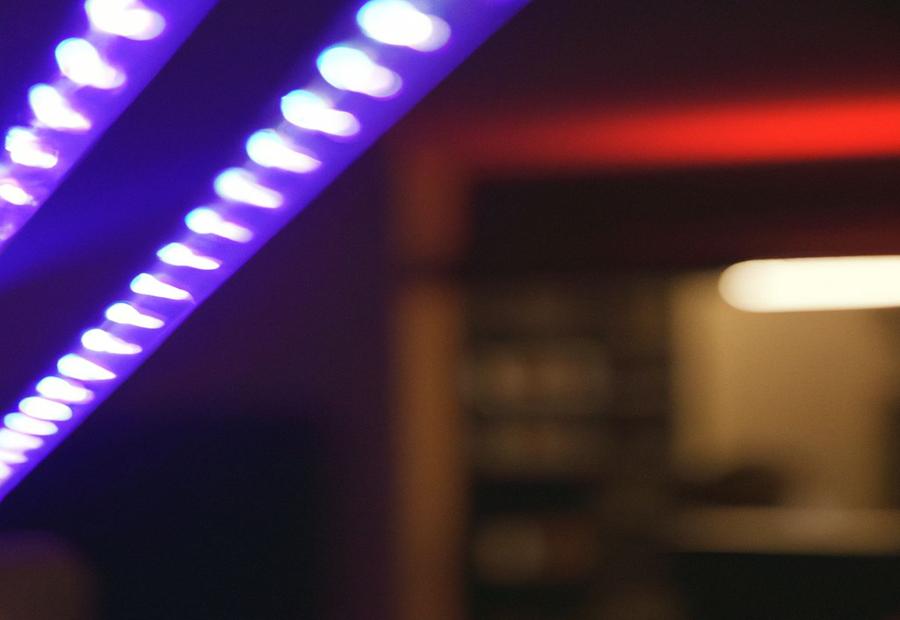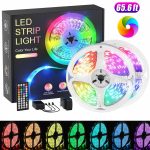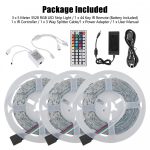Last Updated on 10 months by Francis
.jpg)
LED strip lights have gained popularity due to their versatility and energy efficiency. However, it’s essential to understand the cost implications of running LED strip lights in your home or business. To determine the cost, various factors need to be considered. Let’s explore how LED strip lights work and the factors that affect their running cost.
LED strip lights work by utilizing light-emitting diodes (LEDs) as the light source. These diodes generate light when an electric current passes through them. LED technology is highly energy-efficient as it converts a large portion of electrical energy into light, rather than heat, unlike traditional incandescent bulbs.
Several factors determine the cost associated with running LED strip lights. These factors may include:
- The wattage of the LED strip lights: The power consumption of LED strip lights varies depending on the wattage. Higher wattage LED strip lights will consume more electricity and, consequently, incur higher running costs.
- Duration of use: The amount of time the LED strip lights are in operation will impact the overall cost. The longer the lights are on, the more electricity they will consume and the higher the cost.
- Electricity rates: The cost of electricity, as determined by your utility provider, will directly impact the running cost of LED strip lights. Higher electricity rates will result in higher costs.
- Energy-efficient features: Some LED strip lights come with energy-saving features such as dimming capabilities or motion sensors. These features can help reduce electricity consumption and lower the running cost.
To calculate the cost of running LED strip lights, you can multiply the wattage of the lights by the duration of use in hours and then multiply it by the electricity rate per kilowatt-hour. This will give you an estimate of the cost incurred per day, month, or year.
To reduce the cost of running LED strip lights, consider the following tips:
- Choose energy-efficient LED strip lights: Opt for lights with lower wattage ratings or those that come with energy-saving features to minimize electricity consumption.
- Optimize the use of LED strip lights: Only use the lights when needed and consider using timers or sensors to control their operation. This will help avoid unnecessary energy usage.
- Consider solar or battery-powered options: If feasible, explore solar-powered or battery-powered LED strip lights to reduce reliance on electricity and lower running costs.
By understanding how LED strip lights work and the factors that affect their cost, you can make informed decisions to optimize energy usage and minimize expenses.
Contents
Key takeaway:
- LED Strip Lights are energy efficient: LED strip lights consume less energy due to their low wattage compared to traditional lighting options. This can help to reduce electricity costs and minimize environmental impact.
- Factors affecting the cost of running LED strip lights: The wattage of LED strip lights, the duration of use, electricity rates, and energy-efficient features all play a role in determining the overall cost of operating LED strip lights.
- Tips to reduce the cost of running LED strip lights: Choosing energy-efficient LED strip lights, optimizing usage by turning them off when not needed, and considering solar or battery-powered options can help to lower the cost of running LED strip lights.
How Do LED Strip Lights Work?

Photo Credits: Infraredforhealth.Com by Jacob Wilson
LED strip lights are a type of lighting system that operates using a series of light-emitting diodes (LEDs) mounted on a flexible circuit board. These LEDs emit light when an electrical current is applied to them. The strips are designed to be easily installed in different locations due to their self-adhesive feature.
The LEDs used in strip lights are semiconductors that produce light when an electrical current passes through them. The color of the emitted light is determined by the materials used in the LED. With different LEDs, a variety of colors can be produced, allowing for a wide range of lighting options.
To power LED strip lights, an electrical power source is required. These strips typically operate at low voltage, so a transformer is used to convert the standard household voltage to the lower voltage needed by the LEDs. This enables energy-efficient operation and minimizes the risk of electric shock.
Controlling LED strip lights can be done through a variety of methods, such as using remotes, mobile apps, or switches. This gives users the ability to adjust the brightness, color, and even create dynamic lighting effects according to their preferences.
Factors Affecting the Cost of Running LED Strip Lights
Running LED strip lights can have varying costs depending on several factors. In this section, we’ll uncover what affects the overall expense involved. Exploring the wattage of the LED strip lights, duration of use, electricity rates, and energy-efficient features will provide valuable insights into how these aspects influence the cost. By understanding these factors, you can make informed decisions that balance both functionality and affordability.
Wattage of the LED Strip Lights
The wattage of the LED strip lights plays a crucial role in their usage. It determines the power consumption and can have an impact on overall operating costs.
| LED Strip Light Wattage | Power Consumption |
| 12 watts per meter | Low power consumption |
| 24 watts per meter | Medium power consumption |
| 36 watts per meter | High power consumption |
The wattage of the LED strip lights is directly proportional to the brightness and intensity of the emitted light. Lights with lower wattage consume less power while still providing sufficient illumination. On the other hand, spaces that require a brighter light might necessitate the use of higher wattage lights.
Choosing LED strip lights with the appropriate wattage is essential to strike a balance between desired lighting levels and energy consumption. This not only helps in reducing electricity costs but also promotes energy efficiency.
To maximize the benefits of LED strip lights, it is advisable to use low-wattage options in areas where sufficient lighting is needed. Save higher-wattage lights for locations that require brighter illumination. Moreover, turning off the LED strip lights when not in use can further reduce power consumption and extend their lifespan.
Duration of Use
The duration of use plays a crucial role in determining the electricity consumption and cost of running LED strip lights. To better understand this, let’s refer to a relevant table:
| Duration of Use | Electricity Consumption |
| 2 hours/day | 0.06 kWh |
| 4 hours/day | 0.12 kWh |
| 6 hours/day | 0.18 kWh |
| 8 hours/day | 0.24 kWh |
The above table clearly demonstrates how the duration of use impacts the electricity consumption of LED strip lights. It is evident that as the usage time increases, the consumption of electricity also rises. Therefore, when estimating the running costs of LED strip lights, considering the duration of use is essential.
To minimize expenses, it is advisable to optimize the usage of LED strip lights by turning them off when not required. Additionally, incorporating timers or motion sensors to regulate their operation can be highly beneficial. These measures significantly reduce electricity consumption, resulting in long-term cost savings.
Remember to select energy-efficient LED strip lights that consume less power while maintaining ample brightness. By doing so, you can enjoy the advantages of LED lighting while minimizing its impact on your monthly electricity bill.
Electricity Rates
When considering the cost of running LED strip lights, one important factor to take into account is electricity rates. The electricity rates in your area will determine the amount you will be charged for the energy consumed by the LED lights.
| Location | Electricity Rates |
| City A | $0.12 per kilowatt-hour |
| City B | $0.10 per kilowatt-hour |
| City C | $0.15 per kilowatt-hour |
The table above provides examples of different electricity rates in different cities. It is important to be aware of the electricity rates in your area to estimate the cost of running your LED strip lights. Higher electricity rates will result in higher electricity bills, while lower rates can lead to cost savings.
By understanding the electricity rates specific to your location, you can calculate the cost of running your LED strip lights more accurately and make informed decisions about energy usage.
Energy Efficient Features
When considering energy efficient features for LED strip lights, it is important to keep several factors in mind:
- Low heat output: LED strip lights are renowned for their low heat generation, making them more energy efficient compared to traditional lighting options. This characteristic not only saves energy but also minimizes the risk of overheating and potential fire hazards.
- Energy efficiency: LED strip lights excel at converting electrical energy into light. They consume significantly less power than incandescent or fluorescent lights, resulting in lower electricity bills and reduced energy consumption.
- Long lifespan: LED strip lights have a longer lifespan than other lighting options, typically ranging from 30,000 to 50,000 hours. This means less frequent replacements, leading to cost savings and reduced waste.
- Dimmability: Many LED strip lights offer dimmable features, allowing users to adjust the brightness according to their needs. This not only provides flexibility but also conserves energy by using lower light levels when full brightness is not required.
- Instant on: LED strip lights instantly turn on at full brightness without any warm-up time, unlike some other types of lighting. This feature ensures immediate illumination and eliminates the need to wait for the lights to reach their full brightness, saving both time and energy.
By considering these energy efficient features, you can select LED strip lights that not only provide optimal lighting but also help reduce energy consumption and save on electricity costs in the long run.
Calculating the Cost of Running LED Strip Lights
To calculate the cost of running LED strip lights, you need to consider the total power consumption of the lights and the electricity rate. Here is a table showing the calculation based on an example:
| LED Strip Light | Power Consumption (Watts) |
| Strip Light A | 10 |
| Strip Light B | 8 |
| Strip Light C | 12 |
Assuming the electricity rate is $0.15 per kilowatt-hour (kWh), we can calculate the cost of running the LED strip lights for a certain period. For example, if you use Strip Light A for 4 hours per day, the daily energy consumption would be 10 W x 4 hours = 40 watt-hours (Wh), which is equal to 0.04 kilowatt-hours (kWh). The daily cost of running Strip Light A can be calculated as 0.04 kWh x $0.15 = $0.006.
Similarly, you can calculate the daily cost for Strip Light B and Strip Light C using their respective power consumption values. Remember to multiply the daily cost by the number of days you plan to use the LED strip lights to calculate the total cost. By following this calculation method, you can accurately determine the cost of running LED strip lights and make informed decisions based on your energy usage and budget constraints.
Tips to Reduce the Cost of Running LED Strip Lights

Photo Credits: Infraredforhealth.Com by Andrew Harris
Looking to save some bucks on running LED strip lights? Here are some nifty tips to cut down those costs! Discover the power of choosing energy-efficient LED strip lights and optimizing their usage for maximum efficiency. And hey, have you ever considered solar or battery-powered options? We’ve got you covered with everything you need to know. Get ready to light up your space without breaking the bank!
Choose Energy Efficient LED Strip Lights
When choosing energy efficient LED strip lights, it is important to consider the following:
- Choose high-quality LED light strips that are specifically designed for energy efficiency. These strips typically use low-power consumption LED bulbs, which help to reduce electricity usage.
- LED lighting strips offer several advantages in terms of energy efficiency. They have a longer lifespan compared to traditional lighting options, which means they won’t need to be replaced as frequently. This not only saves money but also reduces waste.
- Consider the brightness and light density of the LED strip lights. It is recommended to opt for strips that provide sufficient illumination while consuming minimal energy. This will help enhance energy efficiency while still meeting your lighting needs.
- If you have multiple areas that require lighting, it is advisable to choose connected LED light strips. This allows for better control and optimization of energy usage. You can turn off specific sections when not in use, reducing unnecessary electricity consumption.
- When selecting the length of LED strip lights, take into account the specific area or application. Choose a length that meets your needs without excess waste. Avoid purchasing longer strips than necessary, as this can result in higher energy consumption.
- For backlighting drawers or specific features using LED strip lights, ensure that the lights are positioned properly to maximize energy efficiency. Correct placement will minimize unnecessary light spillage and maximize the desired effect.
By considering these factors and selecting energy-efficient LED strip lights, you can reduce your energy consumption and environmental impact while still enjoying the benefits of LED lighting.
Optimize the Use of LED Strip Lights
To optimize the use of LED strip lights, consider the following:
- Connected LED Light Strips: Connect multiple LED light strips together for seamless lighting across larger areas.
- Light Density: Choose LED strips with the appropriate density of LEDs per meter to achieve the desired brightness and uniformity of light.
- Strip Length: Determine the appropriate length of LED strip needed for your space, ensuring that it provides sufficient lighting coverage.
- Backlighting Drawers: Use LED strip lights to backlight drawers and create a visually appealing and functional lighting solution.
By optimizing the use of LED strip lights in these ways, you can create customized lighting solutions that enhance the ambiance and functionality of your space.
Consider Solar or Battery-powered Options
When considering the cost of running LED strip lights, it is worth considering solar or battery-powered options. These alternatives provide more flexibility in terms of placement and can help reduce electricity consumption. Here are some reasons to consider solar or battery-powered options:
- Energy savings: Solar-powered LED strip lights harness the sun’s energy, eliminating the need for electricity. This can result in significant cost savings over time.
- Portability: Battery-powered LED strip lights offer the convenience of being portable, allowing you to place them wherever needed without being restricted by electrical outlets.
- Versatility: Solar or battery-powered LED strip lights open up opportunities for creative lighting installations outdoors, such as illuminating pathways, garden features, or the festive season, like lighting up a Christmas tree.
- Sustainability: By considering solar or battery-powered options, you can reduce your carbon footprint and contribute to a more sustainable environment.
Consider these alternatives when deciding on the best option for your LED strip lighting needs. Whether you’re looking for energy savings, portability, versatility, or sustainability, solar or battery-powered options can be an excellent choice to consider.
Some Facts About How Much It Costs to Run LED Strip Lights:
- ✅ LED strip lights use up to 90% less energy than traditional incandescent bulbs. (Source: localelectricalgroup.co.uk)
- ✅ The cost of running a typical 5-meter LED strip light is around $3.65 per year when used for 10 hours per day. (Source: ledlightinginfo.com)
- ✅ LED strip lights consume relatively little electricity, with a minimal impact on electricity bills. (Source: localelectricalgroup.co.uk)
- ✅ A standard 5-meter LED strip light uses around 6.5 Watts per hour. (Source: ledlightinginfo.com)
- ✅ LED strip lights have a longer lifespan of 15,000 to 50,000 hours compared to traditional incandescent bulbs. (Source: localelectricalgroup.co.uk)
Frequently Asked Questions
1. How much does it cost to run LED strip lights?
Running LED strip lights is cost-effective compared to traditional lighting options. The cost depends on factors such as the length, LED density, and power consumption of the strip. A standard 5-meter LED strip will cost just over $3 per year to run.
2. Do LED strip lights consume a lot of electricity?
No, LED strip lights are energy-efficient and consume relatively little electricity. They use up to 90% less energy than traditional incandescent bulbs. The power consumption of an LED strip depends on factors like its length, LED density, and individual LED size.
3. How do I calculate the running cost of LED strip lights?
To calculate the running cost of LED strip lights, you need to know the length in meters and power consumption in watts per meter. Use the formula: Annual Power Consumption (kW/h) = Power (Watts) x Time (Hours) x 365 / 1000. Multiply the result by your electricity tariff to find the annual running cost.
4. Are LED strip lights safe to leave on all night?
Yes, LED strip lights are safe to leave on all night. They have a low fire risk and their electricity usage won’t significantly increase your bill. However, leaving lights on can affect sleep quality. Using red light can help minimize the impact on sleep.
5. How long do LED strip lights last?
LED strip lights are durable and can last up to 40 years. They have a longer lifespan compared to traditional incandescent and fluorescent bulbs, averaging between 15,000 to 50,000 hours. High-quality LED light strips are recommended for extended use.
6. Are there any disadvantages to using LED strip lights?
While LED strip lights have many advantages, including energy efficiency and longevity, they may have a colder color quality compared to traditional bulbs. Some LEDs emit blue light that can disrupt sleep. Additionally, upfront costs can be higher, and compatibility with fixtures or dimmer switches may vary.

.jpg)


.jpg)



